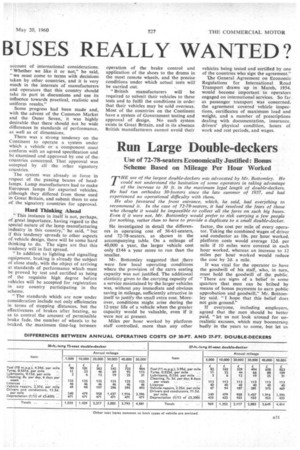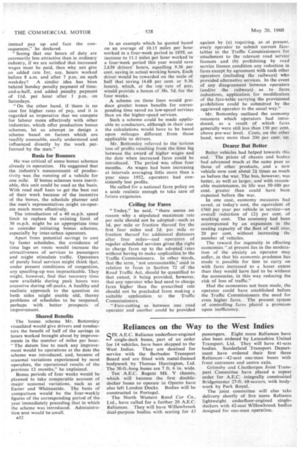Run Large Double-deckers
Page 65

Page 66

If you've noticed an error in this article please click here to report it so we can fix it.
Use of 72-78-seaters Economically Justified: Bonus Scheme Based on Mileage Per Hour Worked
THE use of the largest double-deckers was advocated by Mr. Bottomley. He could not understand the hesitation of some operators in taking advantage of the increase to 30 ft. in the maximum legal length of double-deckers. He had run orthodox 30-footers since the late summer of 1957, and had experienced no operational difficulty with them.
He also favoured the front entrance, which, he said, had everything to recommend it. In the case of 72-78-seaters, it had resolved the fears of those who thought it would be impossible to collect all the fares on such big buses. Even if it were not, Mr. Bottomley would prefer to risk carrying a few people for nothing, rather than to have to provide a duplicate to a small double-decker.
He investigated in detail the differences in operating cost of 56-61-seaters, and 72-78-seaters, as shown in the accompanying table. On a mileage of 40,000 a year, the larger vehicle cost only £144 a year more to run than the smaller.
Mr. Bottomley suggested that ,there were few local operating conditions where the provision of the extra seating capacity was not justified. The additional elasticity given to the carrying capacity of a service maintained by the larger vehicles was, without any immediate and obvious saving in mileage, sufficiently attractive in itself to justify the small extra cost. Moreover, conditions might arise during the l2-year life of a vehicle when the greater capacity would be valuable, even if it were not at present.
Miles per hour worked by platform staff controlled, more than any other factor, the cost per mile of every operator. Taking the combined wages of driver and conductor as 10s. per hour worked, platform costs would average 12d. per mile if 10 miles were covered in each hour worked, whereas an increase to 12 miles per hour worked would reduce the cost by 2d. a mile.
if was vital for the operator to have the goodwill of his staff, who, in turn, must hold the goodwill of the public. "There are signs of a belief in some quarters that men can be bribed by means of bonus payments to earn public approbation and goodwill," Mr. Bottomley said. "I hope that this belief does not gain ground."
If everyone, including employers, agreed that the men should be better paid, "let us not look around for unrealistic excuses, which may boomerang badly in the years to come, but let us instead pay up and face the consequences," he declared.
"Seeing that our hours of duty are necessarily less attractive than in ordinary industry, if we are satisfied that increased wages must be paid, then why not give an added rate for, say, hours worked before 8 a.m. and after 7 p.m. on each weekday? A similar idea has been behind Sunday penalty payment of timeand-a-half, and added penalty payment of 11d, per hour after 1 p.m. on Saturdays.
"On the other hand, if there is no case for higher rates of pay, and it is regarded as imperative that we compete for labour more effectively with other industries, which offer production bonus schemes, let us attempt to design a scheme based on factors which are readily assessable, easily understood and influenced directly by the work performed by the men."
Basis for Bonuses
He was critical of some bonus schemes already in operation. He suggested that the industry's measurement of productivity was the running of a vehicle for one mile. If bonus schemes were inevitable, this unit could be used as the basis. With road staff keen to get the best out of their work because of the incentive of the bonus, the schedule planner and the men's representatives might co-operate much more effectively.
The introduction of a 40 m.p.h. speed limit to replace the existing limit of 30 m.p.h. might be an appropriate time to consider initiating bonus. schemes, especially by inter-urban operators.
Apart from potential saving i in cost by faster schedules, the avoidance of time lags en route would increase the attractiveness of services to passengers and might stimulate traffic. Operators of purely local services might think apt, under present conditions of congestion, any speeding-up was impracticable. They might, however, find that recovery time now available during peak hours was excessive during off-peaks. A healthy and realistic approach to the question on both sides might enable old, thorny problems of schedules to be reopened, perhaps with better prospects of improvement.
Shared Benefits
The bonus scheme Mr. Bottomley visualized would give drivers and conductors the benefit of half of the savings in hours worked brought about by improvements in the number of miles per hour. "The datum line to mark any improvement would be operations at the date the scheme was introduced, and, because of seasonal variations experienced by most operators, the operational results of the previous 12 months," he explained.
Bonus periods of four weeks would be planned to take comparable account of major seasonal variations, such as at Easter and Whitsuntide. The basis of comparison would be the four-weekly figures of the corresponding period of the year immediately preceding that in which the scheme was introduced. Administration cost would be small.
832 In an example which he quoted based on an average of 10.15 miles per hour worked in a four-week period in 1959, an increase to 11.1 miles per hour worked in a four-week period this year would save 2,639 drivers' hours, equalling 9.36 per cent. saving in actual working hours. Each driver would be rewarded on the scale of half that saving (4.68 per cent. or 9.36 hours), which, at the top rate of pay, would provide a bonus of 38s. 5d. for the four weeks.
A. scheme on these lines would produce greater bonus benefits for corresponding time saved on low-speed services than on the higher-speed services.
Such a scheme could be made applicable to conductors, although in their case the calculations would have to be based upon mileages different from those applicable to drivers.
Mr. Bottomley referred to the serious loss of profits resulting from the time lag between the award of higher wages and the date when increased fares could be introduced. The period was often four months. As wages had been increasing at intervals averaging little more than a year since 1952, operators had consistently lost profits.
He called for a national fares policy on a scale realistic enough to take care of future exigencies.
Ceiling for Fares
"Today," he said, "there seems no reason why a stipulated maximum rate per mile should not be adopted—such as 3d, per mile or fraction thereof for the first four miles and 2d. per mile or fraction thereof for additional distances after four miles—and operators of regular scheduled services given the right to charge fares up to the adopted rates without having to make application to the Traffic Commissioners. In other words, that the term, 'not unreasonable,' used in relation to fares in Section 72 of the Road Traffic Act, should be quantified to that extent, it being provided, however, that any operator who had need to charge fares higher than the prescribed rate should not be precluded from making a suitable application to the Traffic Commissioners.
Fare-cutting as between one road operator and another could be provided against by (a) requiring, as at present, every operator to submit current faretables to the Traffic Commissioners for attachment to the relevant road service licences and (b) prohibiting by road service licence -condition any reduction in fares except by agreement with such other operators (including the railways) who provided alternative services. In the event of any disagreement between operators (and/or the railways) as to fares reductions, application for modification of the fare-table carrying the provisional prohibition could be submitted by the aggrieved operator in the usual way."
. Mr. Bottomley outlined the economy measures which operators had introduced, as a result of which fares generally were still less than 150 per cent. above pre-war level. Costs, on the other hand, were more than 200 per cent. up.
Dearer But Better
Better vehicles had helped towards this end. The prices of chassis and bodies had advanced much at the same pace as those of other products, and a new vehicle now cost about 2f times as much as before the war. The bus, however, was better, as well as larger, and with reasonable maintenance, its life was 50-100 per cent, greater than could have been expected before the war.
In one case, economy measures had saved, at today's • cost, the equivalent of £560 per year per vehicle in service—an overall reduction of 12f per cent. of working cost. The economy had been accompanied by an expansion in the seating capacity of the fleet of well °vet 20 per cent, without increasing tilt number of vehicles.
The reward for ingenuity in effecting economies "at present lies in the moderation of the anxiety an operator may suffer, in that his economic prudence has made it. possible for him to carry on with fares increased to a lesser extent than they would have had to be without the economies, in this way reducing the risk of loss of traffic."
Had the economies not been made, the operator could have established before the Traffic Commissioners the need for even higher fares. The present system. of controlling fares placed a premium upon inefficiency.




















































































































